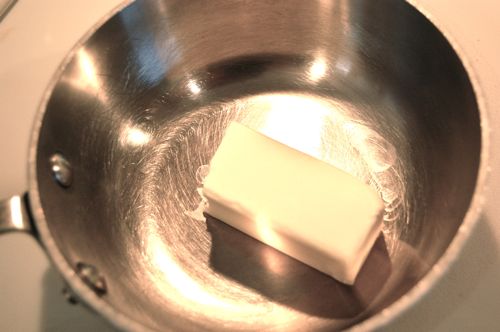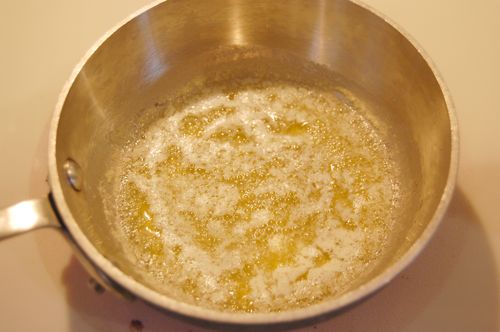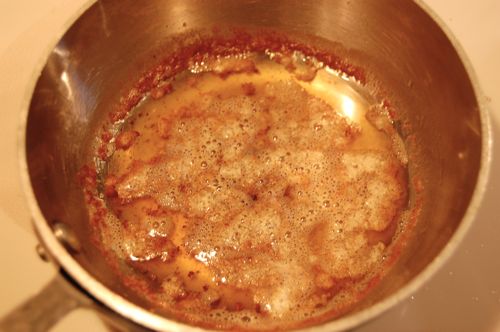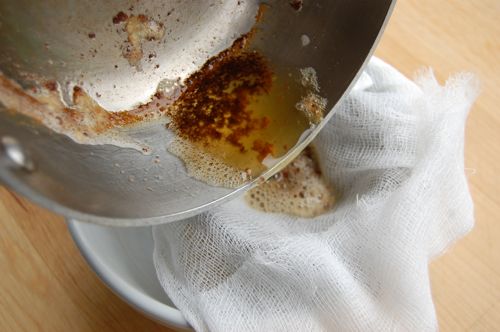How to clarify (brown) butter
It an easy thing, but sometimes it helps to see it, yes? If a recipe calls for, say, four tablespoons of clarified butter, I’ll start out with a little extra since I expect to lose some in the process. Here I have about 4 1/2 tablespoons of fresh, unsalted butter:

I heat it up until it begins to bubble gently…see the proteins collecting there on the top?

That right there is what a lot of cooks call clarified butter, and if I were adding this to a yellow cake, I’d stop. However since I happen to want a nice nutty brown butter taste this time, I’ll continue until some of the solids begin to sink and burn, and the rest turn golden brown.

I then strain the whole mess through a small sieve lined with cheese cloth…

..and there you have it: clarified (and in this case, browned) butter. Substitute a tablespoon or so of this for some solid butter the next time you make brioche…you won’t be disappointed.

UPDATE: Chef Mike writes in to say he uses a coffee filter to strain out the solids…a very good idea.
UPDATE: Nick from imafoodblog.com suggests a short stack of three slightly damp paper towels if you find yourself without cheese cloth.
Hi Joe,
I’m a new reader on your blog and I think you’re such a great teacher! It feels like I’m going through Pastry School all over again each time I read a post.
Clarified butter so pretty (:
Oh yes, isn’t it tho? Sometimes I think I’d like to drink the stuff.
But thanks so much for the generous compliment! Please come back often!
Ah! I thought the first time I read your recipe it specified clarified butter. I’m glad to see that it actually says browned butter.
The recipe I’ve always used is Sherry Yard’s and she suggests stirring in all the browned bits. In fact, she considers them an important flavor component. And, following that philosophy, I’ve begun to brown butter whenever possible in all my baking and also to substitute brown sugar as much as possible for granulated and buttermilk for whole milk. That’s a lot of extra flavor potential.
Speaking of Ms. Yard, in The Secrets of Baking she has a master recipe for financier plus chocolate, gingerbread, pumpkin and carrot variations. We’ve had her pumpkin financier baked as a layer, split and filled with lemon curd for Thanksgiving on a number of occasions. YUM! For my money, much more interesting than pumpkin pie.
Wow, all that sounds excellent. I know that book and it’s wonderful. I have yet to try the financiers, however. Maybe this is a good time to try them!
Thanks!
– Joe
Hi Joe! Something I’ve always wondered about brown butter is if it’s just the floating little bits that get browned, or does all of the butterfat get browned as well? The few times I’ve tried to make brown butter I’ve either tried to get the actual liquid butterfat too brown, and thus burned the browned bits, or I’ve stopped when the browned bits are just right but then feel like the butterfat itself isn’t browned. Sorry for the spectacularly imprecise question–my vocabulary in this area isn’t too refined. I hope you can comprehend my question through all that alliteration!
Hey Erica!
Actually the fat doesn’t brown, just the milk solids. The fat itself would start to smoke, then burn before it actually browned. That means the lipids themselves are starting to degrade and break apart, which means a lot of weird off flavors to say nothing of a potential fire risk! So really all you want are the browned solids. Those will give you the best flavor.
Thanks for the great question!
– Joe